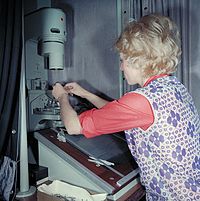
Photo from wikipedia
Abstract Technical quality assurance (QA) and quality control (QA/QC) are important activities within medical laboratories to ensure the adequate quality of obtained test results. QA/QC tools available at medical laboratories… Click to show full abstract
Abstract Technical quality assurance (QA) and quality control (QA/QC) are important activities within medical laboratories to ensure the adequate quality of obtained test results. QA/QC tools available at medical laboratories include external QC and internal QC, patient-based real-time quality control (PBRTQC) tools such as moving average quality control (MAQC), limit checks, delta checks, and multivariate checks, and finally, analyzer flagging. Recently, for PBRTQC tools, new optimization and validation methods based on error detection simulation have been developed to obtain laboratory-specific insights into PBRTQC error detection. These developments have enabled implementation and application of these individual tools in routine clinical practice. As a next step, they also enable performance comparison of the individual QA/QC tools and integration of all the individual QA/QC tools in order to obtain the most powerful and efficient QA/QC plans. In this review, a brief overview of the individual QA/QC tools and their characteristics is provided and the error detection simulation approaches are explained. Finally, a new concept entitled integrated quality assurance and control (IQAC) is presented. To enable IQAC, a conceptual framework is suggested and demonstrated for sodium, based on available published data. The proposed IQAC framework provides ways and tools by which the performance of different QA/QC tools can be compared in a so-called QA/QC error detection table to enable optimization and validation of the overall QA/QC plan in terms of alarm rate as well as pre-analytical, analytical, and post-analytical error detection performance.
Journal Title: Critical Reviews in Clinical Laboratory Sciences
Year Published: 2022
Link to full text (if available)
Share on Social Media: Sign Up to like & get
recommendations!